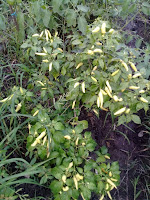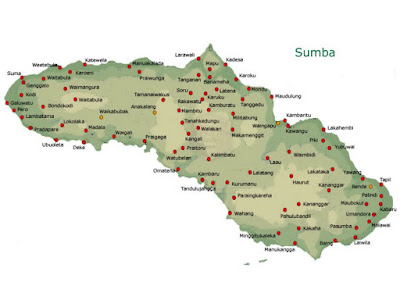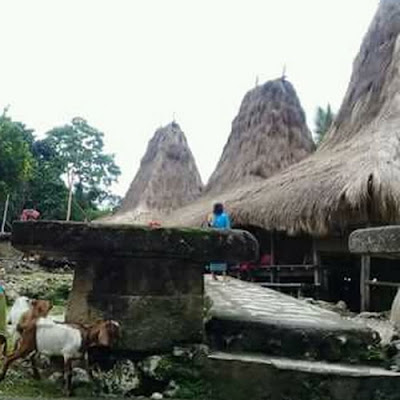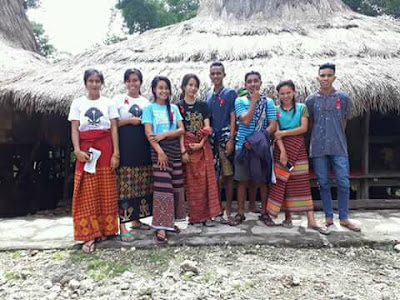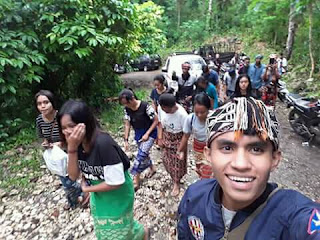Rethinking Organic Farming in Sumba
Tuesday, 12 June 2018by adminstube
Organic farming is nature harmony agriculture having balanced relationship between human and nature, that people maintainthe natural habits and use natural methods in processing agricultural land so that the environment remains sustainable and the ecosystem balance continues to be maintained.
 In the southern part of Indonesia which stretches as tropical savannah with an area of 7.000,5 km2, that is the island of Sumba. The mainland of Sumba is a living place for Sumbanese and various other tribes with diverse cultural and religious backgrounds as well as agricultural and livestocks as a support for the economic of the region. Sumba island consists of four districts, namely East Sumba, Central Sumba, West Sumba and Southwest Sumba, with their own uniqueness, for example East Sumba has a vast agricultural area that can be cultivated by its inhabitants to produce food in a natural way without using chemicals. Basically, farming in Sumba is still natural because it depends on the season, which the dry season is longer than rainy, so agricultural processing is only done when the rainy season approaching. When the dry season the agriculture land becomes grazing field for livestocks. Agricultural land rests and even gets fertilizer from animal waste which increases soil nutrients.
In the southern part of Indonesia which stretches as tropical savannah with an area of 7.000,5 km2, that is the island of Sumba. The mainland of Sumba is a living place for Sumbanese and various other tribes with diverse cultural and religious backgrounds as well as agricultural and livestocks as a support for the economic of the region. Sumba island consists of four districts, namely East Sumba, Central Sumba, West Sumba and Southwest Sumba, with their own uniqueness, for example East Sumba has a vast agricultural area that can be cultivated by its inhabitants to produce food in a natural way without using chemicals. Basically, farming in Sumba is still natural because it depends on the season, which the dry season is longer than rainy, so agricultural processing is only done when the rainy season approaching. When the dry season the agriculture land becomes grazing field for livestocks. Agricultural land rests and even gets fertilizer from animal waste which increases soil nutrients.
How is the opportunities for organic farming in Sumba?
The area of agricultural land in East Sumba is around 8.358.00 Ha, based on the data of National Statistical Institute (BPS)2014. It shows that the opportunity for organic farming in East Sumba can be the modal for competing in local and national markets. The commodities for local markets arevegetables, tubers, and nuts. While commodities for national markets are cashews, cotton, areca nut, coffee and chocolate.Unluckily the agriculture products are sold as raw material, not processed into derivative products yet. It impacts on low income and lackness of innovation capability of farmers. The existence of traditional farmers who farm naturally should be maintained and even assisted with knowledge and skills of utilizing local materials as organic fertilizers and pesticides to improve the quality of crops and harvests. This is the duty of every stakeholders who competent in agriculture to carry out these tasks, although in general it is all Sumbanese’s responsibility.
How is the interest of Sumba young people in agriculture?
 The influence of modernization has reached Sumba including its youth. Most of them are not longer interested to be farmers. They prefer to work as civil servants or company employees because they are considered more elite. There is an assumption that becoming farmer can reduce prestige and desire to earn money without waiting or processing such as farming from cultivating land, caring for crops until harvesting time. This is not entirely wrong because agriculture is considered not prospective. It needs efforts to raise awareness and view of young people on agriculture by showing the prospects of agriculture, as experienced by Frans Fredi and Aloysius, two young Sumba youth who dare to start organic farming in Lambanapu area, East Sumba. Hopefully the actions of these two young people can awaken the movement of young people to love organic farming in Sumba.
The influence of modernization has reached Sumba including its youth. Most of them are not longer interested to be farmers. They prefer to work as civil servants or company employees because they are considered more elite. There is an assumption that becoming farmer can reduce prestige and desire to earn money without waiting or processing such as farming from cultivating land, caring for crops until harvesting time. This is not entirely wrong because agriculture is considered not prospective. It needs efforts to raise awareness and view of young people on agriculture by showing the prospects of agriculture, as experienced by Frans Fredi and Aloysius, two young Sumba youth who dare to start organic farming in Lambanapu area, East Sumba. Hopefully the actions of these two young people can awaken the movement of young people to love organic farming in Sumba.
It should be admitted that the application of organic farming require synergy from local governments as policy makers, agricultural agency as arm of government that accompany farmers, community organizations as counterweight and farmers who cultivate the land. In the future, an optimistic attitude, willingness to learn and common goals need to be possessed, so organic farming in East Sumba will develop and compete in the national market. Hopefully. (Yanto Umbu Muri).
Finding the Charm of Black Sands Beach
Monday, 11 June 2018by adminstube
 Have you ever heard the name of Black Sands beach? Some people will frown their forehead when they are asked? Yet having visited, even never heard about it, as many people have less information about it. Black Sands Beach is a beach with black sands, located in Middle Sumba, precisely at Mananga village, Mamboro district.
Have you ever heard the name of Black Sands beach? Some people will frown their forehead when they are asked? Yet having visited, even never heard about it, as many people have less information about it. Black Sands Beach is a beach with black sands, located in Middle Sumba, precisely at Mananga village, Mamboro district.The Black Sands beach is still underestimated not only by the government but also the people due to the belief that the beach is not widely known and the black sand itself is not considered as beneficial thing to be promoted. However, many tourists with special interests came to see the beach with unique black sands.
Despite its name, there is no clear historical record about the place, however, this black sand is believed as a heritage from the ancestors and described as a hidden black pearl. The black sand itself is unique, in addition to its blackness, the sand is glossy. When it’s combined with the coral cliffs and the exotic coral caves, it completes the savanna that drapes the path to the beach.
Majority of the people who live near the beach believe in Islam due to their origins which is not from Sumba, and to make a living they work as fishermen. This location had a substantial fish deposits so it’s rare seeing fishermen come back with empty basket, this makes people flocks to the location to purchase sea products, apart from the beach.
The 140-kilometer trip from Waingapu to Black Sands Beach takes up three to four hours to reach Waibakul in Middle Sumba, then turning right to Mamboro’s harbor. Unluckily, there is no public transport available to bring you there. Therefore, you’ll be better to rent a car or a motorcycle.
Black Sands Beach can be an alternative destination for the tourists in Sumba in which they can find many things, such as the uniqueness of the black sand, relieving their wear and tire from working routine, enjoying the tree-capped coral cliffs, seeing the vast savanna, and buying fishermen’s recently caught fishes. But it needs to be aware, that there are not many facilities on the beach, therefore tourists who want to experience the beach needs to bring their own meal. (Jekson H. Tana)
Giving Impact through Writing
Saturday, 9 June 2018by adminstube
Writing is important because by writing someone can practice hobby, express feelings and even influence others. One needs to practice his/her writing skills because writing is a combination of knowledge and art. So, more often someone writes, more eloquent and skillful to string words into writing.
Writing skills need to be owned by students, so Stube-HEMAT Sumba as a student mentoring institution facilitated them with Journalistic training. The training in Waingapu took place at the secretariat of Stube-HEMAT Sumba since Wednesday, May 16, 2018. Yanto Hangga, one of Stube-HEMAT Sumba team opened a series of trainings by giving an introduction of participants,explaining the program and objectives of the event. He also introduced Trustha Rembaka, S.Th, coordinator Stube-HEMAT Yogyakarta, who facilitated training to equip students to know and apply writing skills.
Sixteen participants attended the training and they came from various campuses in East Sumba including the Nursing academy of Waingapu, Wirawacana Christian University, AKN and several community activists such as Ana Humba Community and Ana Tana Community.
In introduction session, Trustha invited participants to share their own sub-district and the potencies. However there weresome participants who had difficulty explaining the village and its potencies. Actually self-recognition is the starting point for ?someone to start writing by revealing the plus and minus of their origin. Then, through writing, someone will be known even after he/she passed away because writing remains eternal. We are the persons who are in Sumba able to know Indonesian and world leaders because of writings. We may agree with them because their thoughts for the nation and humanity are manifested in their writings.
The first step of writing is to recognize the types of writing, such as Reportage, a writing that cover of events in the field according to the facts; Opinion, a type of writing in the form of opinions, ideas in response to a problem, in which the author analyzes the problem and provides alternative solution; Feature, a short, informative and inspiring writings which discusses characters, tourist attractions and culture; and Poetry, a writing of feelings and sometimes symbolic expressions that is bonded to certain rules such as number of lines, number of syllables and vocals. Further, the participants determined the topic of writing in accordance with their interests and created framework of writings that they would made.
The next meeting was a small class which facilitated participants to discuss with the facilitator. This method wastaken in order that the process of writing mentoring workedmore effectively and participants were free to discuss their writings. Only eight of sixteen participants followed this consultation meeting. It should be admitted that writing wasnot easy, but some participants were eager to complete their writings.
"I was so inspired by this meeting, actually, writing was beneficial for me even though it is difficult at the beginning. I can share information, even it can be published in printed media someday, however, the most important thing is that I am passionate about learning journalism itself”, said Yanto Umbu Muri, a student of Wirawacana Christian University.
To be a young writer who has some impacts must be inititatedsince now, so, start writing right now. (Sarimita Andani Ata’ambu).
Note: Journalism Class also took place at Lewa facilitating students of Theological Institute of Sumba Christian Church. There were seven students of theology and Christian education study program attending the class. They were from Mamboro, Kodi, Lewa, Waikabubak and Waingapu. They learned similar topic as journalistic classes in Waingapu.
Man & Woman, Equal?
Thursday, 7 June 2018by adminstube
We can find a lot of cases of violence towards women in Indonesia. The numbers of the cases which aren't subliminal require an in-depth attention from all those in charge. Gender inequality happens in many aspects, to name a few, in the term of expressing own opinion and participating in mass organizations and public service. This issue has become the responsibility of many parties to unite against gender equality.
Currently, Indonesian society, especially women are fighting intensely for their rights, for gender equality. Many actions have been done, doing demonstrations, performing art show, and writing articles about women. This term is widely known as gender equality, which means a fair and balanced treatment and roles between men and women in the society. Gender equality is still not fully materialized in Indonesia due to factors such as the lack of knowledge about gender equality, society's assumption that women are weak, patriarchy's strong grip, and low numbers of women participation in public sectors.
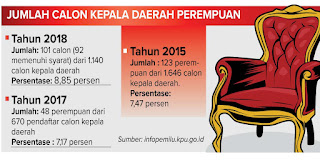 Concrete evidence for this can be found in politics where patriarchy still has a tight grip. According to PERLUDEM (Association for General Election and Democracy) in 2017, simultaneous regional election showed that women participation only counts for 7, 17% of the total 614 candidates for regional leaders at the entirety of Indonesia (perludem.org). Actually women with great potential for the nation and country are not scarce, we can see this through the role of women teachers that ‘gave birth' to influential persons.
Concrete evidence for this can be found in politics where patriarchy still has a tight grip. According to PERLUDEM (Association for General Election and Democracy) in 2017, simultaneous regional election showed that women participation only counts for 7, 17% of the total 614 candidates for regional leaders at the entirety of Indonesia (perludem.org). Actually women with great potential for the nation and country are not scarce, we can see this through the role of women teachers that ‘gave birth' to influential persons. In Sumba, one of the islands in East Nusa Tenggara, we can find many cases of gender inequality. Ranging from the opportunity to study in university to decision making, we can find man has much more opportunities and is regarded as more capable compared to women. Therefore, the fight for gender equality still has a long way to go and requires multiple parties to involve in the conquest for gender equality.
In Sumba, one of the islands in East Nusa Tenggara, we can find many cases of gender inequality. Ranging from the opportunity to study in university to decision making, we can find man has much more opportunities and is regarded as more capable compared to women. Therefore, the fight for gender equality still has a long way to go and requires multiple parties to involve in the conquest for gender equality. Church's Role, churches are critical parts on the conquest of gender equality. Preachers can influence their congregation on the importance of women's role in decision making, doing services and activities that give benefits both the church and the society.
Church's Role, churches are critical parts on the conquest of gender equality. Preachers can influence their congregation on the importance of women's role in decision making, doing services and activities that give benefits both the church and the society. Government's Role, as a policy maker, government needs to give attention and have a good will towards women, starting from discussions among the populace with the topic of women empowerment, and educating people about the misunderstanding that men are considered superior beings in patriarchy system. Furthermore, the government needs to eliminate the stigma amongst the populace that women are inferior beings and ‘kitchen occupant'.
Government's Role, as a policy maker, government needs to give attention and have a good will towards women, starting from discussions among the populace with the topic of women empowerment, and educating people about the misunderstanding that men are considered superior beings in patriarchy system. Furthermore, the government needs to eliminate the stigma amongst the populace that women are inferior beings and ‘kitchen occupant'. Family's Role is not less important, that’s why family is required to teach their children in the term of gender equality, as actions of the populace is a reflection of what happens inside the family.
Family's Role is not less important, that’s why family is required to teach their children in the term of gender equality, as actions of the populace is a reflection of what happens inside the family.As a conclusion, if you care about yourself, your mother and your woman, and all women, let's join the struggle to realize gender equality, not only in Sumba but also in our country. (Antonia Maria Oy).
Titus Wanda: The Guardian of Sumbanese Art and Tradition
Thursday, 7 June 2018by adminstube
"Limalangu, limalangu", said a middle-aged man while he stepped out of his house welcoming us at Waimiripu Tana Mbokar art studio, Kalumbang, East Sumba. He is Titus Wanda, a figure and art practitioner, born in June 19, 1947. The word 'limalangu' itself has a meaning of peaceful in the heart, a welcome greeting bringing sense of peace in the heart.
The name of Titus Wanda is familiar among local people because of his passion and love for Sumbanese cultural arts, as he devotes his life to preserve cultural arts of Sumba throughhis an art studio called ‘Waimiripu Tana Mbokar’, which meansliving water of sustainable soil, that can be translated as preserving the original dances of Sumba so they will besustainable.
He acknowledged that time is unavoidable either for Sumba and its youth generation. They are attracted to something modern, and unfortunately forget their own cultures because no one introduces cultures to them. Moreover, the practitioners of Sumbanese art and tradition are old, and without efforts to inherit it, they will be lost. He initiated action to establish an art studio to preserve Sumbanese dances and local languages that were almost extinct and to prevent negative influences from other cultures, to increase and direct Sumba art activities, especially original Sumbanese culture, such as dances, songs, woven fabrics and cultural arts instruments.
For this reason, in August 17, 2004, ‘Waimiripu Tana Mbokar’art studio was officially founded. Located in Kalumbang, East Sumba. The affirmation of the existence of the studio is getting stronger after obtaining a notary certificate in July 15, 2015 when he registered it to Tourism Office of East Sumba regency as a way to show the existence of ‘Waimiripu Tana Mbokar’. The organizers are Titus Wanda, Afliani, Christofel Njurumana (head of sub-district), Dominggus (head of sub-district) and Didimus J. Dewa (retired civil official).
The activities are held twice a week in Kalumbang. The dancers are children from elementary school to high school and grouped into six female and four male dancers, two drummers, four ‘kakalak’ and four gongs. The age range is around 5-10 years old for children and 11-20 year old for adult dancers. The frequent performed dance is ‘Ninggu Harama’ (a war dance), two female dancers holding machete and two male dancers holding shields and spears for self-defense. There are also entertainment dances such as ‘Kabokang’ and ‘Kandingang’ performed by four male dancers and six female dancers. The art studio has performed dancers for several times at provincial events, national independence day anniversaries, welcoming guests, thanksgiving, church anniversaries, and weddings. The income fund from the stage invitation is distributed evenly to the members.
Titus Wanda who was a facilitator in Stube-HEMAT Sumba training on Tourism also explained the meaning of symbols in Sumbanese woven fabrics, such as horses (ndjara) symbolize welfare or strength, rooster (manu) symbolizes leadership and heroism, parrots symbolize forum deliberance, human symbolizesadmiration, skulls (andung) symbolize death for securitydefense, deer symbolize pride or arrogance, while shrimp symbolizes resurrection behind death.
"This is what I can do to preserve cultural arts of Sumba and I am working for people, church and Sumbanese custom. We pray for each of us peace in our hearts, limalangu", said Titus Wanda who is also actively involved in ministry in Christian Church of Sumba at Payeti congregation, Waingapu.
Yes, it must be acknowledged that the preservation of arts and cultures in such a region, especially Sumba, return back to the awareness and commitment of the present generation to keep and preserve them. Hopefully. (Valentino).
Kampong Tambera: As If Delving Into The Past
Wednesday, 6 June 2018by adminstube
A long-buried desire finally came true when I visited kampong Tambera in Doka Kaka village, Loli sub-district, Western Sumba regency when I was attending Wai Humba VI festivity in 2017. Wai Humba itself is a festival aiming to increase the relation between man and God which is manifested in preserving the nature and environment. The festivity at that time uses the theme of “We are not human marching to extinction”.
To reach kampong Tambera from Eastern Sumba’s district capital, Waingapu requires approximately three hours travel by motorcycle. However, vehicles are unable to reach the kampong due to the existence of a 20-steps staircase to get from the village administration center to the kampong’s field. Therefore, from the village administration center, I needed to go uphill on foot due to the location of the kampong itself which is built on the top of a hill and surrounded by thick groves.
Due to the feature and contour, stony and not plain, the kampong’s field is terraced. The custom houses were built terraced on the edge of the field from the entry gate until the rear end of the kampong. The beams and floorings of the houses mostly made from forest logs. In the centre of the field, there are stone tombs with various length and shapes, from round to oval and square.
With the mild air, surrounded by trees, and also the hospitality of the commoners reflected a serene and peaceful living, this kampong is different from others. Visitors of this kampong is expected to keep their manner in order, including I that also need to control mouth by not insulting the rato (kampong’s chief) due to the tradition in this kampong which is still well-maintained.
This kampong is an Ina-Ama (Mother-Father) kampong or the main spiritual site of the Loli tribe. This kampong is also the home of Wulla Poddu ritual, a sacred ritual of the disciples of Marapu, a traditional belief of ethnic Sumba people. This ritual is held a whole month.
Other uniqueness that I found in this kampong is the residents cannot use synthetic flavorings for cooking. The only flavoring they are allowed to use is basil leaves and other natural ingredients, even salt is forbidden. However, with those restrictions, the food they made still tastes good. Next, it doesn’t mean that all kampong Tambera residents don’t use salt for cooking, because most of the kampong Tambera residents don’t reside there permanently, as only certain persons are allowed to take permanent resident in this kampong.
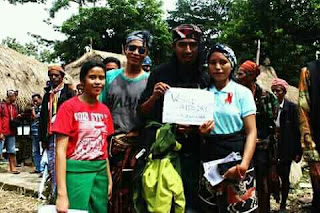 I’m grateful to be able to visit kampong Tambera and I’m fascinated with the existence of old but well-maintained housings. Here in the kampong, I learned how to struggle to achieve a goal, unite with nature, and also appreciated how the culture and tradition which existed hundreds of years ago are still practiced in the current time. (Apronia Dai Duka)
I’m grateful to be able to visit kampong Tambera and I’m fascinated with the existence of old but well-maintained housings. Here in the kampong, I learned how to struggle to achieve a goal, unite with nature, and also appreciated how the culture and tradition which existed hundreds of years ago are still practiced in the current time. (Apronia Dai Duka)Wednesday, 6 June 2018
by adminstube
 The real situation above is one of the social problems as well as business opportunities in the field of horticultural agriculture. Some young people who are still students majoring in economics and also members of Stube-HEMAT Sumba, see a potency for business opportunity in such situation. Therefore, they formed a Young Farmers Community who decided to become a business actor in agriculture. The strategy in developing agriculture is by establishing a center of agricultural production. The goal is to maximize natural resources and educate public that a village or a place can be recognized with its superior products.
The real situation above is one of the social problems as well as business opportunities in the field of horticultural agriculture. Some young people who are still students majoring in economics and also members of Stube-HEMAT Sumba, see a potency for business opportunity in such situation. Therefore, they formed a Young Farmers Community who decided to become a business actor in agriculture. The strategy in developing agriculture is by establishing a center of agricultural production. The goal is to maximize natural resources and educate public that a village or a place can be recognized with its superior products.
 Currently Fredi and Aloysius are building Horticulture business and developing some 4000 seedlings of chili, 1,000 seedlings of watermelon and some other plants such as melon, cabbage, papaya, purple eggplant and pariah in Lambanapu. While at the same time, Hendrikus Hina Lunggu Manu and Francis K. Halang developed a hybrid corn business in a 2 Ha field in Kadumbul.
Currently Fredi and Aloysius are building Horticulture business and developing some 4000 seedlings of chili, 1,000 seedlings of watermelon and some other plants such as melon, cabbage, papaya, purple eggplant and pariah in Lambanapu. While at the same time, Hendrikus Hina Lunggu Manu and Francis K. Halang developed a hybrid corn business in a 2 Ha field in Kadumbul.
 This community business development is not only focused on the members but also coaching for young people so they can grow as young business actors and can meet the needs of everyday life. (Frans Fredi Kalikit Bara)
This community business development is not only focused on the members but also coaching for young people so they can grow as young business actors and can meet the needs of everyday life. (Frans Fredi Kalikit Bara)
by adminstube
Young People
Falling in Love
With Agriculture
East Sumba Regency is one of the districts in East Nusa Tenggara that is rich of natural resources. One of them is agriculture. Wetland area in East Sumba regency is about 15,601 Ha and dry land area 547,701 Ha (BPS Kabupaten Sumba Timur, 2016: 193-197). Astronomically the district of Sumba Timur is between 119 ° 45-120 ° 52 East Longitude (BT) and 9 ° 16-10 ° 20 South Latitude (LS). Geographically, East Sumba regency has northern boundaries with the Sumba Strait, south to the Indian Ocean, east to Sabu Sea, west to Central Sumba Regency (BPS of East Sumba District, 2016: 3).
The market demand of Waingapu is instable, sometimes it is overproduction, other wise, there is a stock shortage. Actually, there are several horticulture centres that support Waingapu market that is Marada Mundi, Kiritana village, Lambanapu, Mauliru, Maulumbi, Mauhau and Kawangu villages. Several areas above can produce agriculture in the dry season, but others cannot produce because they are on the river bank(Marada Mundi village, Kiritana village) and some other areas have no agriculture innovation in the rainy season.
 The real situation above is one of the social problems as well as business opportunities in the field of horticultural agriculture. Some young people who are still students majoring in economics and also members of Stube-HEMAT Sumba, see a potency for business opportunity in such situation. Therefore, they formed a Young Farmers Community who decided to become a business actor in agriculture. The strategy in developing agriculture is by establishing a center of agricultural production. The goal is to maximize natural resources and educate public that a village or a place can be recognized with its superior products.
The real situation above is one of the social problems as well as business opportunities in the field of horticultural agriculture. Some young people who are still students majoring in economics and also members of Stube-HEMAT Sumba, see a potency for business opportunity in such situation. Therefore, they formed a Young Farmers Community who decided to become a business actor in agriculture. The strategy in developing agriculture is by establishing a center of agricultural production. The goal is to maximize natural resources and educate public that a village or a place can be recognized with its superior products.
The Young Farmers Community has a network with Red Arrow, a provider of quality and reliable seed for the community. Young Farmers Community has members, namely Frans Fredi Kalikit Bara, Aloysius Umbu Sili Ndingu, Hendrikus Hina Lunggu Manu and Francis K. Halang. The strategy is to use social media such as Facebook, Whatsapp, business identity card and direct approach with buyers in the market and in food stalls. This community is optimistic in agricultural production center-based production. One important reason why cultivating this field, because agriculture is a food necessity or basic need and consumers definitely need food every time. Agricultural business is one big business if it is seriously done by utilizing technology and agricultural innovation. In addition, market demand for food will never stop.
 Currently Fredi and Aloysius are building Horticulture business and developing some 4000 seedlings of chili, 1,000 seedlings of watermelon and some other plants such as melon, cabbage, papaya, purple eggplant and pariah in Lambanapu. While at the same time, Hendrikus Hina Lunggu Manu and Francis K. Halang developed a hybrid corn business in a 2 Ha field in Kadumbul.
Currently Fredi and Aloysius are building Horticulture business and developing some 4000 seedlings of chili, 1,000 seedlings of watermelon and some other plants such as melon, cabbage, papaya, purple eggplant and pariah in Lambanapu. While at the same time, Hendrikus Hina Lunggu Manu and Francis K. Halang developed a hybrid corn business in a 2 Ha field in Kadumbul. This community business development is not only focused on the members but also coaching for young people so they can grow as young business actors and can meet the needs of everyday life. (Frans Fredi Kalikit Bara)
This community business development is not only focused on the members but also coaching for young people so they can grow as young business actors and can meet the needs of everyday life. (Frans Fredi Kalikit Bara)













